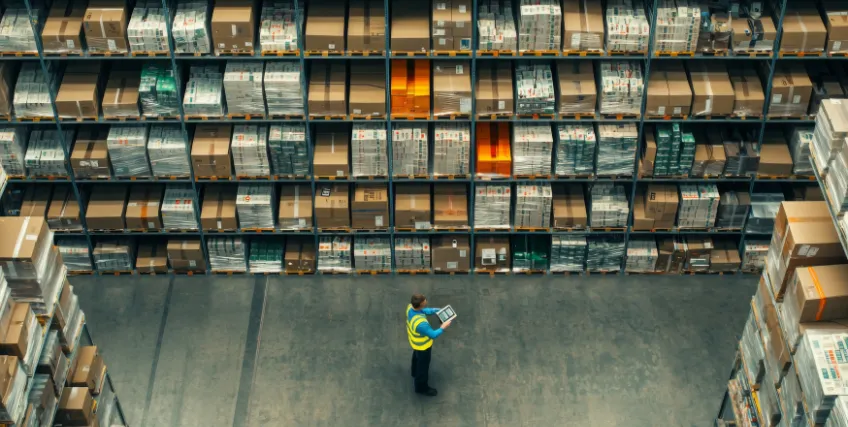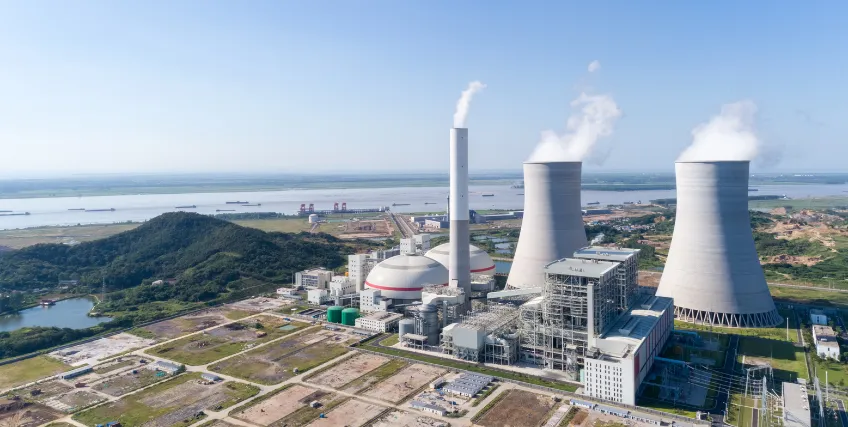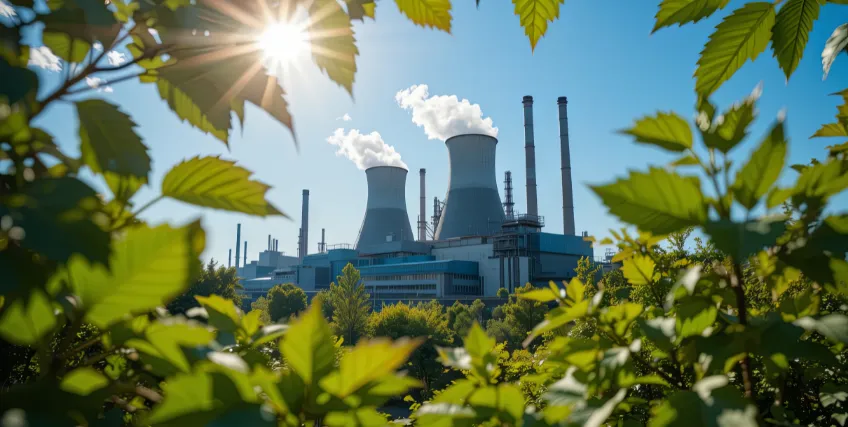How Commercial and Industrial Loans Support Thermal Power Plant Growth
April 24, 2025 | Last Updated on: April 28, 2025

Thermal power plants (TPPs) remain critical in meeting America’s rising energy demand. From natural gas to coal-based facilities, these plants require substantial investments to get off the ground. Whether it's land acquisition, plant construction, equipment upgrades, or emissions reduction—each phase comes with a hefty price tag. This is where business financing becomes essential.
For many energy companies, commercial and industrial loans offer a reliable path to fund large-scale thermal energy projects. These loans cover a wide range of needs, from property purchase and construction to acquiring heavy-duty machinery and modernizing existing facilities.
In this article, we break down how commercial and industrial loans power progress in the thermal energy sector. We also explore options like construction business lines of credit, loan for industrial property, industrial property finance, and business loan for industrial machinery—and how these financial tools help bridge funding gaps.
Why Thermal Power Plants Need Strategic Financing
Launching or expanding a thermal power plant project isn’t cheap. High upfront costs are tied to several key areas:
- Land acquisition and site development
- Permits and environmental clearances
- Engineering services and EPC contracts
- Procurement of machinery and equipment
- Labor and plant construction
- Ongoing operational costs
While the energy sector is shifting toward renewable energy sources, thermal energy still plays an important role in the U.S. power mix but without smart project financing, even promising investment projects can stall.
One option to secure land and infrastructure is a loan for industrial property. Businesses can also explore industrial property finance if they’re acquiring real estate assets or expanding into new locations.
When financing is timed well and backed by the right partner, energy companies can build strong financial models, improve competitiveness, and maintain healthy cash flows. This enables them to tackle both short-term challenges like plant delays and long-term goals like modernization and emissions control.
Proper financing is no longer just a tool, it’s a growth engine.
What Are Commercial and Industrial Loans?
Commercial and industrial loans (also called C&I loans) are business loans designed to support operational, capital, and infrastructure needs of companies across sectors, including the power sector.
These loans are often secured against business assets or project cash flows and come with flexible terms depending on the borrower’s credit profile, project scope, and financials. Unlike personal loans, commercial and industrial loans are tailored to fund:
- Construction
- Equipment acquisition
- Real estate
- Working capital
For energy companies building thermal power plants, C&I loans can be used to finance everything from a processing plant to heavy-duty turbines or boilers. These loans are often structured as term loans or revolving credit facilities, based on the stage and size of the investment project.
C&I loans are usually offered by banks, financial institutions, or specialty business financing providers. They can be structured with variable or fixed interest rates, and repayment terms ranging from short-term to long-term financing options.
In the energy sector, especially for thermal power plant projects, C&I loans serve as essential financial instruments that reduce upfront burden, improve balance sheets, and ensure projects stay on track.
Financing Different Phases of a Thermal Power Plant
1. Land and Infrastructure – Use of Industrial Property Loans
Before any steel is laid, land must be secured. This is where a loan for industrial property or industrial property finance helps. Whether purchasing vacant land or an old facility for retrofitting, these financing options help with down payments, legal clearances, and related costs. Many thermal power plants are located in industrial zones, which means land prices and regulatory hurdles can be steep.
These loans allow developers to move quickly on land acquisition without draining existing reserves.
2. Construction Phase – Using a Construction Business Line of Credit
Plant construction is rarely linear. Delays, design changes, or material shortages often disrupt cash flow. That’s where a construction business line of credit comes into play. It gives you access to revolving funds that can be drawn when needed—ideal for managing engineering services, interim labor costs, and ongoing vendor payments.
This is especially useful for energy projects following an EPC contract or phased rollout.
3. Equipment and Machinery – Loans for Capital Goods
Thermal plants need expensive, large-scale machinery: boilers, turbines, cooling systems, fuel handling units, and emissions control devices. A business loan for industrial machinery helps cover these high-capital items.
Some financial institutions even allow structured repayment plans based on the lifespan of the machinery, helping the borrower align cash flow with loan repayment.
Example: A coal-fired TPP investing in low-emission tech can use this loan to finance the entire retrofit without diverting core capital.
Together, these financing options create a cohesive strategy to execute complex thermal power plant projects efficiently.
Benefits of Commercial and Industrial Loans for the Thermal Energy Sector
Ever wondered why thermal energy businesses rely on commercial and industrial loans? Well, here's why these companies seek these funding options:
1. Capital Access for Large Projects
Most thermal power plants require significant upfront capital to purchase land, acquire permits, or install systems like turbines and boilers. Commercial and industrial loans provide the financial base needed to begin or scale operations. These loans are a go-to for large-scale power sector projects where timing is crucial and traditional bank loans may fall short in meeting custom timelines or specific industry needs.
2. Cash Flow Flexibility
Instead of dipping into reserves or risking liquidity, companies use commercial and industrial loans to maintain steady cash flows. This is essential for managing payroll, EPC contracts, or vendor fees. During construction delays or fuel price surges, having financing ready avoids jeopardizing operations. These loans help manage both day-to-day costs and large milestone payments without financial strain.
3. Asset Leverage
With commercial and industrial loans, businesses can use machinery, land, or future receivables as collateral. This leverage supports improved balance sheet health and enhances your borrowing profile. Lenders see value in tangible project assets, making approval more straightforward for qualified energy developers.
4. Better Vendor Terms
Immediate capital access lets businesses negotiate better terms with suppliers—be it for engineering services, fuel delivery, or turbine installation. Prepaid agreements can lock in discounts or mitigate inflation-related pricing. This makes the loan work both as a funding tool and a strategy for reducing operational costs.
5. Green Transition
Thermal plants aiming to reduce emissions or adopt hybrid models with renewable energy (like solar or biomass) can use these loans to fund their upgrades. Some projects may qualify for federal loan guarantees tied to environmental performance. C&I loans help build long-term competitiveness in a regulatory-heavy landscape.
In a sector that faces both climate regulations and market volatility, C&I loans are a stabilizing force.
What to Consider Before Applying
Not every thermal power plant project needs the same type of financing. Here’s what business owners should assess:
- Project Size: Large-scale projects may need multiple loans (e.g., industrial loans for land, equipment, and construction).
- Timeline: If your project is phased out, a construction business line of credit offers more flexibility than a lump-sum loan.
- Asset Profile: Do you own land or equipment? These can be used to secure better terms on your loan agreement.
- Cash Flow Forecasts: Make sure your financial model reflects realistic revenue timelines to avoid repayment stress.
- Purpose Clarity: Are you funding working capital, buying turbines, or retrofitting a site? The more specific, the better.
Talk to providers who understand the unique needs of energy companies. Online financing platforms for instance, might not provide direct commercial and industrial loans but can offer custom business financing tailored to each project stage’s needs; from land purchase to plant upgrades.
Pro Tip: Always review the fine print. Look out for prepayment penalties, collateral requirements, and any short-term rate hikes.
Conclusion
From site selection to full-scale operations, commercial and industrial loans play a critical role in thermal energy development. These funding tools aren’t just about capital—they’re about timing, flexibility, and growth.
By using targeted financial instruments like a construction business line of credit, a loan for industrial property, or a business loan for industrial machinery, companies can break ground faster, manage operational costs better, and invest in long-term modernization.
As the U.S. energy landscape evolves, the smart use of financing can help thermal operators stay competitive, reduce emissions, and align with broader energy goals.
FAQs
1. What are commercial and industrial loans used for in thermal energy projects?
Commercial and industrial loans fund various stages of thermal power development—from land acquisition and plant construction to machinery purchases and modernization. These loans help businesses cover high-capital expenditures like boilers, turbines, and emissions control systems. Since thermal power projects are capital intensive and span long timelines, C&I loans offer flexible terms and repayment schedules, making them suitable for both short-term and long-term financing needs. They are critical for maintaining stable cash flows while ensuring project continuity and growth.
2. Can I use a construction business line of credit for plant delays or overruns?
A construction business line of credit is ideal for thermal power projects that face unexpected costs or delays. This revolving credit option allows business owners to draw funds only when needed, helping manage engineering services, labor, or material price increases during construction. It provides more flexibility than lump-sum financing and helps stabilize cash flows during unplanned events like equipment delays or EPC contract shifts. For phased builds or expansion projects, this type of financing ensures smooth execution.
3. What’s the difference between a loan for industrial property and equipment loans?
A loan for industrial property is used to purchase land or buildings where thermal plants operate. This may include undeveloped plots or existing facilities needing retrofit. On the other hand, a business loan for industrial machinery helps finance equipment like turbines, generators, and cooling systems. Both are essential for plant development—one for the physical space, the other for operational function. Choosing the right loan depends on whether you're focused on site acquisition or outfitting the plant with machinery critical to thermal energy production.
4. How can industrial property finance help new plant developers?
Industrial property finance offers new developers the upfront capital required to secure land in industrial zones. This financing option helps cover site costs, permits, and development fees. Owning the property gives thermal energy businesses the advantage of long-term control and asset value on their balance sheet. It's especially valuable for businesses entering the energy sector, as it lays the groundwork for scalable infrastructure. With property secured, developers can attract additional funding and move faster into plant construction and operations.
5. Are commercial and industrial loans suitable for small energy companies?
Commercial and industrial loans are often structured to support not just large corporations but also small and regional energy companies. These businesses can use C&I loans to fund thermal power plant projects, purchase equipment, or improve existing infrastructure. When paired with a solid financial model and project plan, small developers can access tailored financing through business financing providers. These loans help smaller players remain competitive in the power sector while expanding their operational footprint and aligning with national energy goals.




